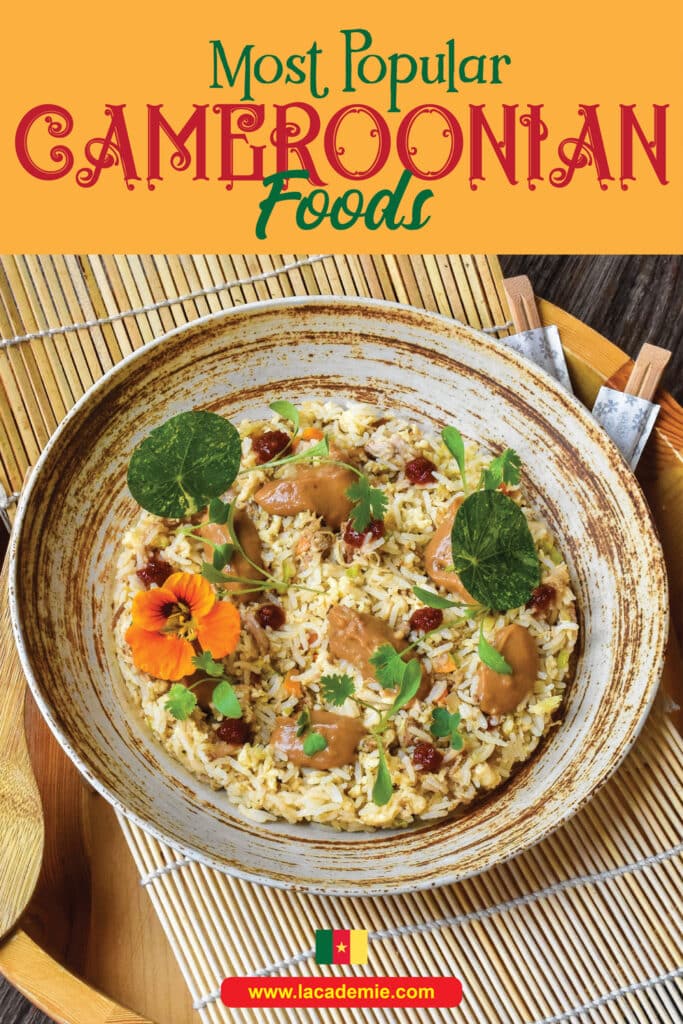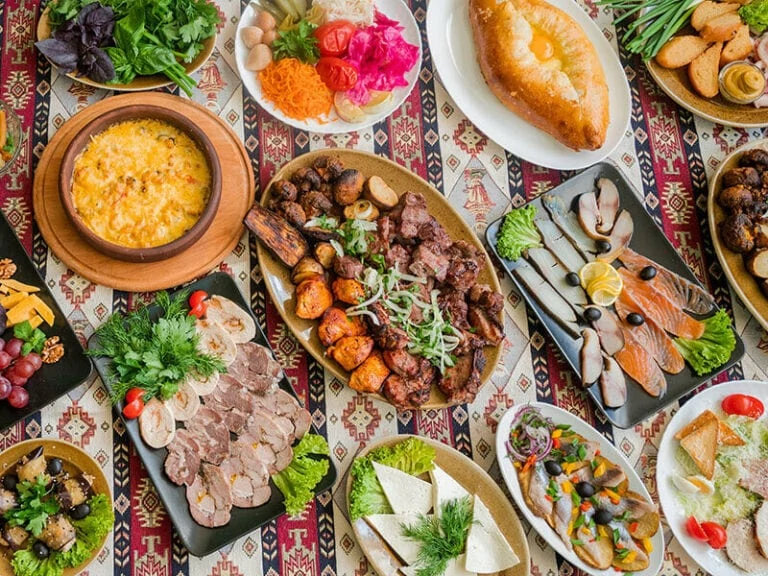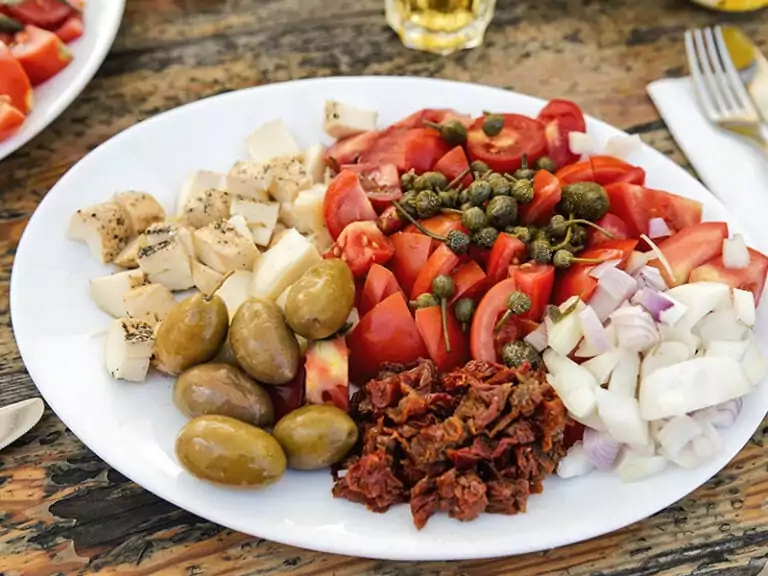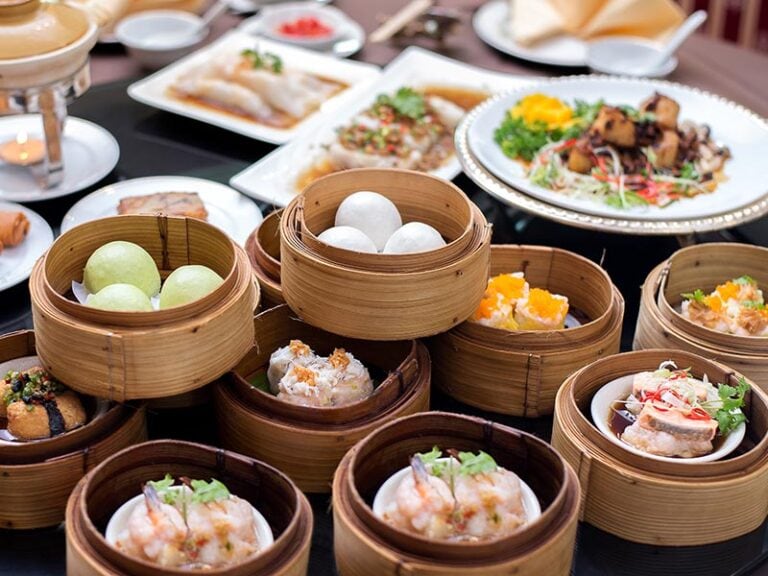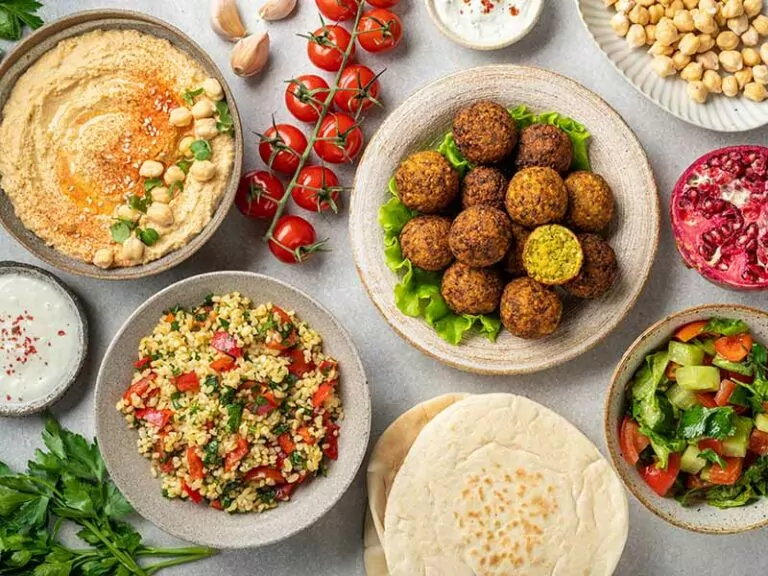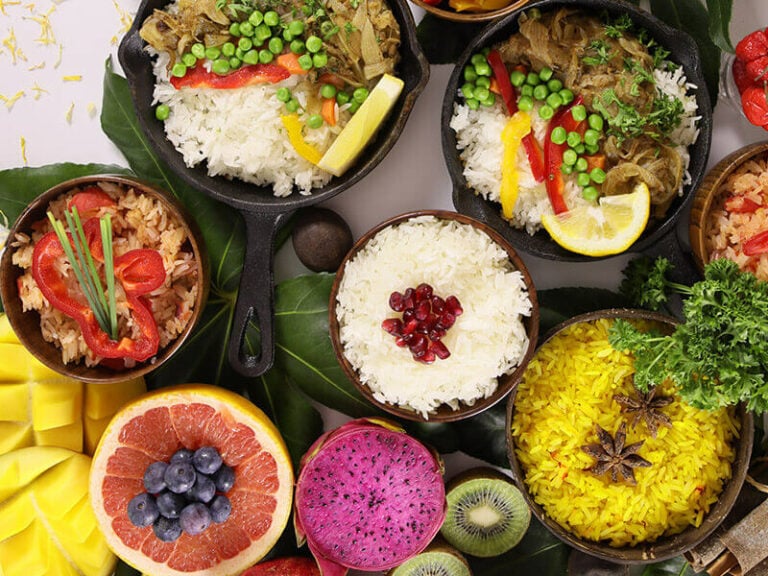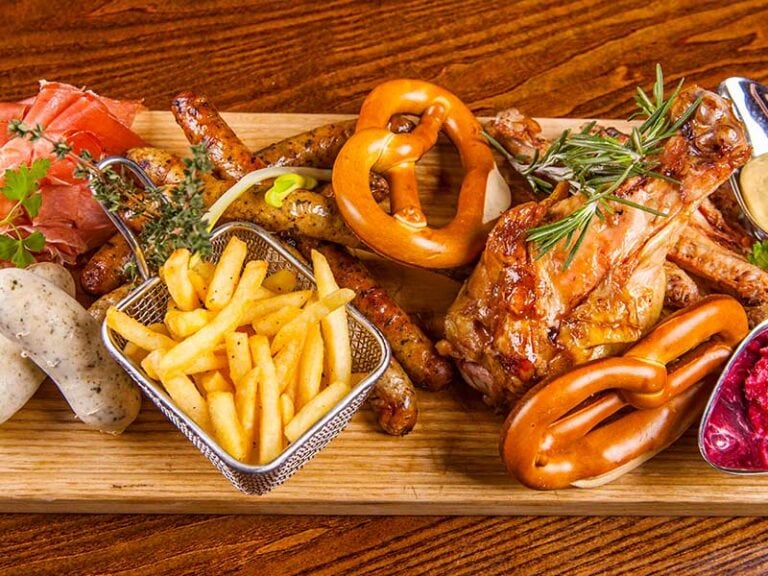For those in love with exquisite African dishes, Cameroonian foods deserve a special place in their heart. There are good reasons for such fondness to flourish. Cameroon has a particularly rich history, with various cultures manifesting themselves in its wide array of dishes.
Many people refer to Cameroon as “Africa in miniature” due to its unrivaled diversity in many aspects. As such, you will never run out of culinary delights to explore in this West African country. Read on to learn what to expect from the hidden jew of the oldest continent.
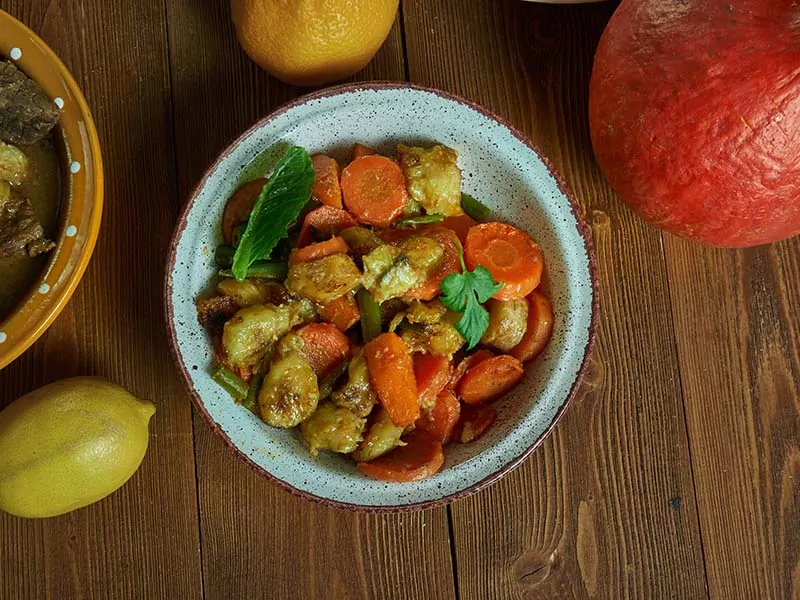
1. Fufu – Doughy Staple Food
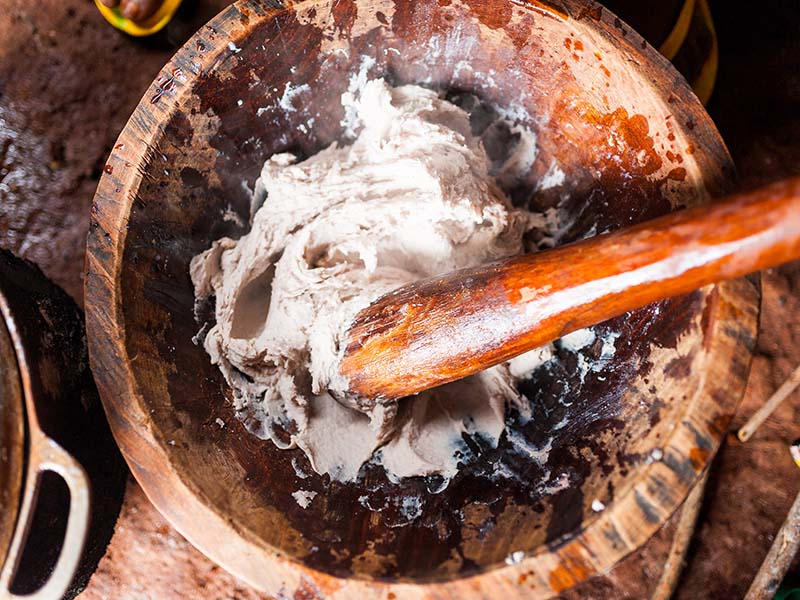
Fufu is the heart of all Cameroonian breakfast dishes. Even if replacing “Cameroonian” with “African” or “Caribbean”, the statement still rings true. That says a lot about how popular this starchy food that you have to eat with your fingers is.
But what is Fufu? It is a milky-white, dough-like dish made from a mixture of boiled cassava, green plantain, or cocoyam (people occasionally include cornmeal and semolina, too). The stuff is pounded with a mortar and pestle before being blended with water until soft and spongy.
Fufu started as a West African staple food before enslaved black people brought them to other places. Besides Cameroon, the dish is a mainstay in Togo, Liberia, Ghana, and many other nations.
In many French-speaking parts of Cameroon, people customarily call it Couscous, although there is nothing in common between the two.
2. Bobolo – Fermented Cassava Dish
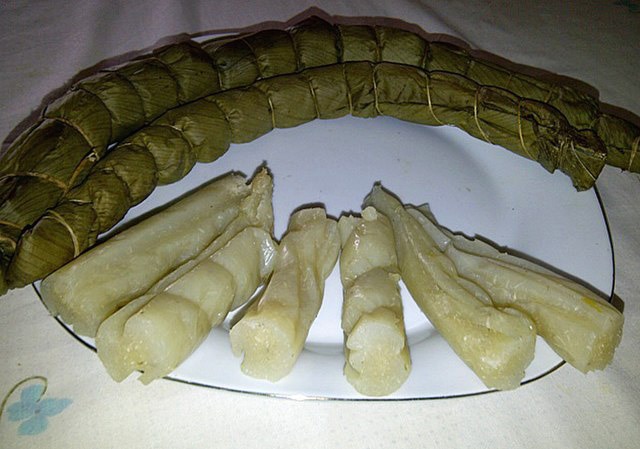
In terms of vitamin and mineral content, cassava is far superior to many starchy vegetables, say, potatoes. But it tends to spoil too easily. Africans in general and Cameroonians, in particular, find a workaround; they turn the vegetable into the more long-lasting Bobolo.
In essence, Bobolo is cassava starch that is fermented and wrapped in banana leaves into long, big sticks. It can last for weeks at room temperature, and many times longer when frozen.
These days, it’s no big deal to purchase frozen Bobolo online or from supermarkets. After dethawing it in hot water and peeling off the banana covering, you can enjoy the tangy cassava alone or as a side dish with other toothsome Cameroonian foods.
3. Kpwem – Casavana Leaf Dish
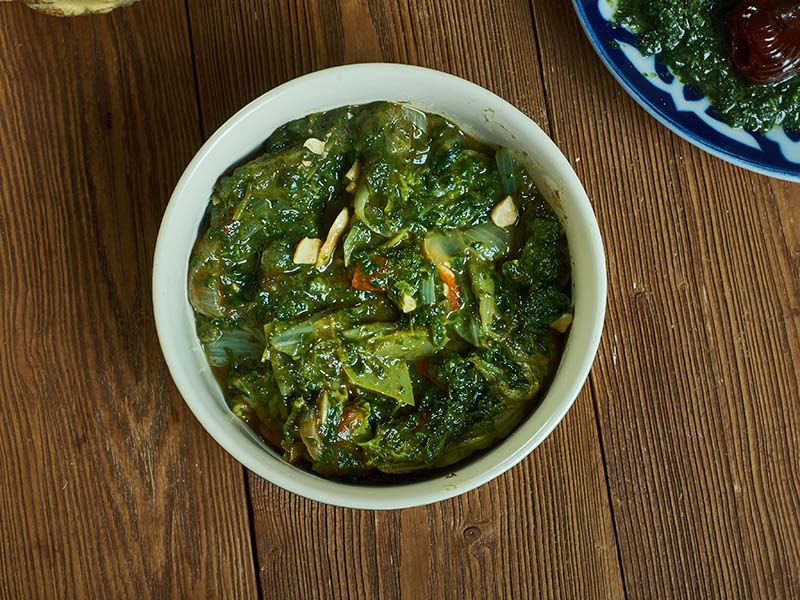
It is difficult to pronounce. It consists of an ingredient that can turn toxic if not properly processed. But it’s healthy, savory, and reminds people strongly of Cameroon. It is Kpwem, a surprisingly wonderful dish to go with rice or cooked plantains.
This exotic dish is made from young and soft cassava leaves. Don’t be alarmed because the leafy green becomes a mine of proteins when cooked.
Locals take advantage of this by mashing and mixing it with peanut butter before boiling the mixture in water into a stew-like dish. A bowl of rice, cooked plantains, or cassava will highlight the grassy taste of Kpwem.
4. Eru Soup
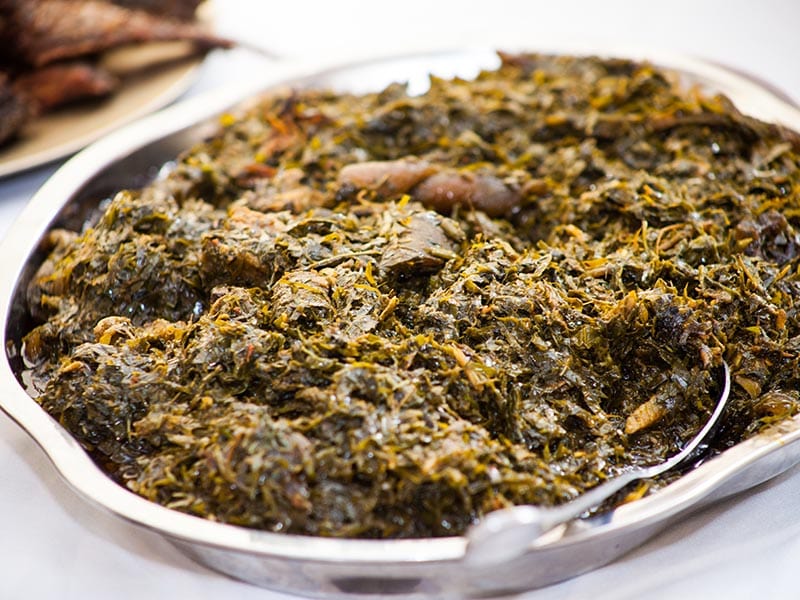
There is a very good reason why many people refer to Cameroon as “Africa in miniature”. The country is home to a mind-blowing number of ethnic groups: more than 200 tribes who speak about 240 languages recognized by the state.
That diversity matters a lot to Cameroonian cuisine. In the Manyu region in the southwestern part of the country live the Bayangi people.
Their specialty is a delicious soup from a mineral-rich vegetable that goes by many names: Eru or Okok in Cameroon, Koko in other African countries.
Eru is a wild vegetable, so villagers wishing to make the soup first have to venture to the forest to gather it. Later, they finely chop the green and cook with spinach, herbs, and even meat for extra nutrients. The smooth, starchy soup goes well with Fufu and roasted cassava.
Turn your stove on to cook homemade Eru soup with this guide.
5. Achu Soup – Yellow Soup
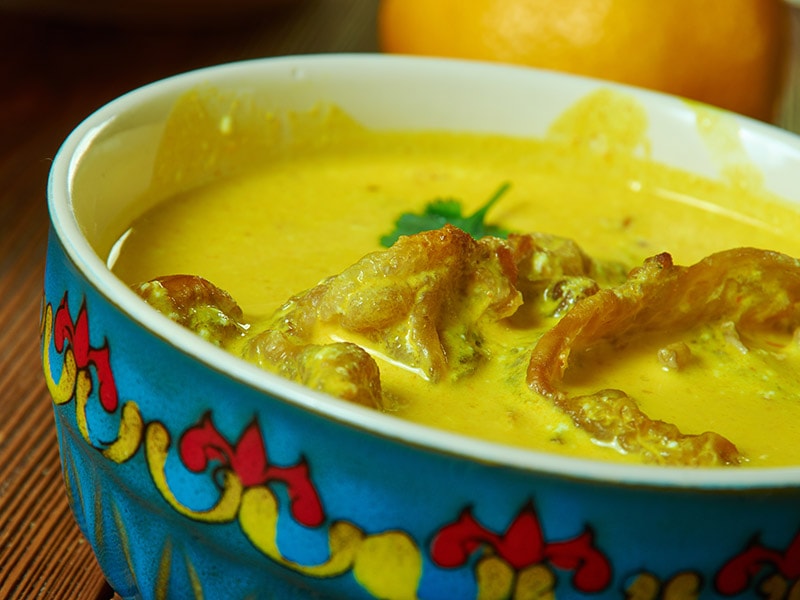
This dish, whose name sounds like a sneeze, is a contribution from the Ngemba people living in northwestern Cameroon. Looking at a bowl of Achu soup, no one can help being attracted to its glorious golden color and rich aroma. It is a perfect side dish to go with fish and meaty foods.
The main ingredients for the soup are cocoyam (taro), spices, and, wait for it, limestone. However, achieving the beautiful yellow appearance requires a lot of palm oil rich in color-giving carotenoids. Interestingly, Cameroon is among the world’s biggest producers of palm oil.
6. Jollof Rice
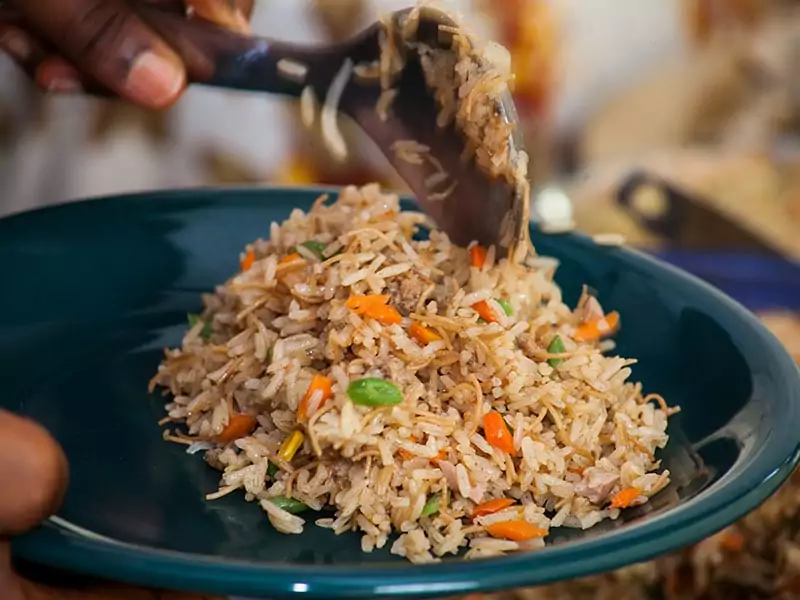
The list of easy yet fascinating Cameroonian dishes can’t be complete without Jollof rice. It first appeared around the 14th century. That coincided with the time of the Wolof or Jolof Empire, a great power that ruled West Africa for nearly two hundred years.
However, the dish appeared to owe its widespread popularity to the contemporary Mali Empire, whose traders spread it far and wide. Today, Jollof rice is the shared traditional dish of many West African countries and is especially famous in Ghanaian cuisine.
But the variation in Cameroon is one of (if not) the best, in my opinion.
It consists of rice, vegetables (onions, garlic, red peppers, etc.), meat, and spices that are cooked together in a pan. In coastal towns, seafood is also a common ingredient. In order for Jollof rice to have its beautiful color, pureed tomatoes or curry powder is added to the pot.
The dish is a ubiquitous sight at many Cameroonian celebrations, from birthday parties to weddings. When you want to order it at a local restaurant, feel free to use its French name Riz Au Gras.
7. Sangah – Cassava Leaf Dish With Corn
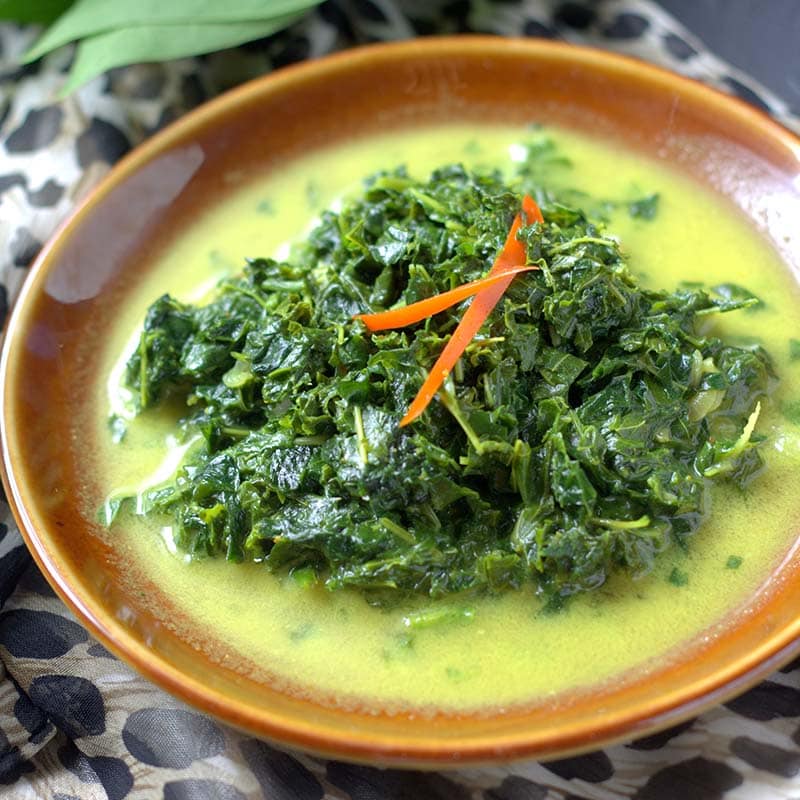
If you want to discard commercially produced foods and turn to simple, healthy eating, Cameroon is a fitting place to start. The country is teeming with unsophisticated recipes evocative of closeness to Mother Nature. One of them is Sangah.
It is a delightful half-stew, half-porridge dish made from corn, pounded cassava leaves, and palm oil. There are similarities between Sangah and the other vegetable dish Kpwem, but the latter doesn’t use corn and is less fatty. The best foods to go with Sangah are rice or cooked plantains.
8. Ekwang – Traditional Cocoyam Dish
What can you do with cocoyam? If your answer revolves around simple methods such as boiling and pan-frying, let’s learn a more complex preparation from the Bafaw people. They live in the southwest region of Cameroon and enrich their country’s cuisine with this delight.
Making Ekwang starts with grating cocoyams into a paste and wrapping bits of it in big, whole leaves. The classic version calls for cocoyam leaves, but outside Cameroon, you can apply a wide range of alternatives, from spinach to collard greens.
It takes a lot of time to form finger-sized, cylindrical Ekwang, but like people always say, patience is a virtue. All that remains is to dump all of them along with crayfish and spices in a fish stock. Cook until you detect a tempting, appetite-whetting smell, then serve Ekwang hot.
9. Banane Malaxé – Topsy Banana Stew
Cameroon was formerly under French rule for half a century. Today, the majority of the Cameroonian population speaks French or a dialect based on it. So it’s no surprise that many dishes in the country have a fancy name, such as Banane Malaxé.
Literally “topsy banana”, the dish is a traditional stew that every Cameroonian enjoys at least once in their life. The name suggests a relatively recent invention, but similar recipes have been around long before the French arrival.
Banane Malaxé includes unripe plantains, peanuts, crayfish, and broth (or bouillon cubes). Fry all the ingredients in palm oil before adding water to the pot and leaving everything simmering until tender. The stew is sufficiently scrumptious already, but fried chicken will make a nice touch to it.
10. Mbongo Tchobi – Spicy Black Stew

The Cameroonian stew Mbongo Tchobi has an unattractive blackish look. But those judging the stew by its cover won’t know how yummy it is.
Mbongo Tchobi consists of rather conventional things: onions, tomatoes, meat, and aromatic spices for flavoring. But the defining ingredient of the stew is the ash from the stick (hiomi) of an indigenous Mbongo tree. It imparts the iconic ebony color to the stew.
No less important are Njansa, a local nutty spice, and the Mbongo spice, also known as alligator pepper. The extremely spicy flavor of the latter is responsible for the unforgettable aroma of Mbongo Tchobi. Let the heart guide you instead of your eyes, and you will find the stew heavenly.
11. Cornchaff – Beans and Sweetcorn Stew
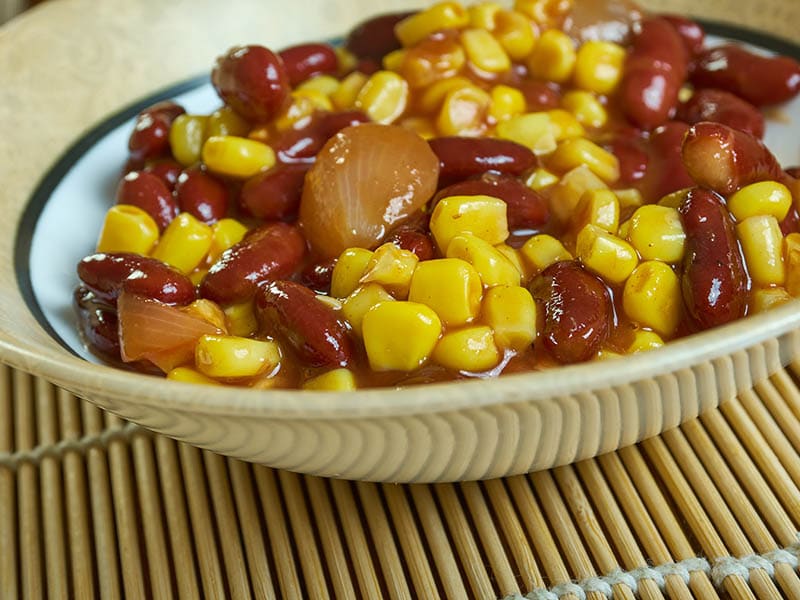
Parts of Cameroon used to be a British dominion, resulting in English being one of the country’s today official languages. Unsurprisingly, you can find many traditional dishes with English names, such as the mouth-watering Cornchaff, which also goes by the name of Adalu.
It isn’t the chaff of corn as you might think. Instead, Cornchaff is a rustic one-pot dish of beans, corn, onions, and potent spices. A heartier version may add crayfish, meat, and chicken broth to improve the flavor, but this isn’t always necessary.
Besides Cameroon, Cornchaff is a favorite with the people of Nigeria, Ghana, and Congo. It is an irresistible comfort food for everyone who likes to relish sweet treats.
12. Ndolé – Nut and Bitter Leaf Stew
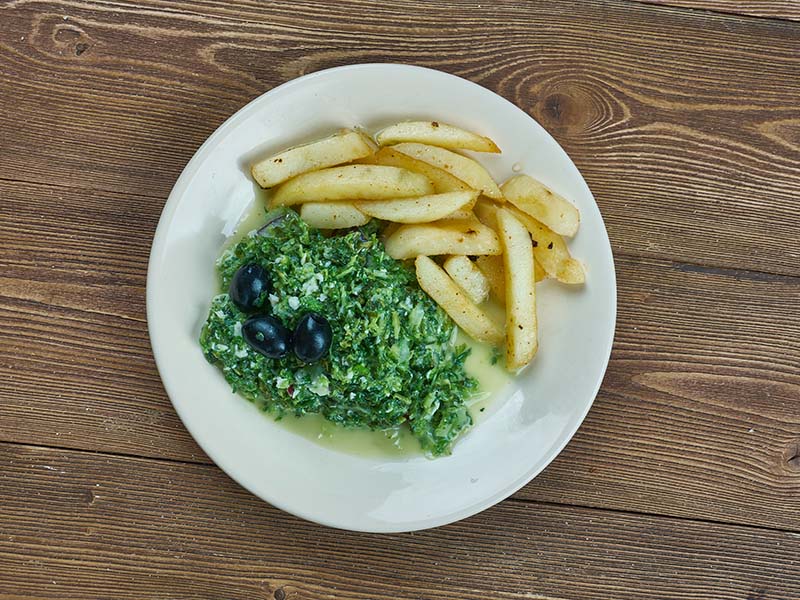
When talking about yummy Cameroonian lunch dishes, you shouldn’t fail to bring up Ndolé. It is one of the country’s national dishes and an integral component of the local menu for festivities. Whether it’s the National Day, Christmas, or New Year, there is no escape from Ndolé.
The cream of this flavor-packed recipe is ndoleh (West African bitter leaves) from which it derived its name. Accompanying the leafy green are melon seeds, melon seeds, and meat or fish. They are cooked until well-infused with each other’s flavor.
Most Cameroonians pair Ndolé with Fufu, Bobolo, or boiled plantains. When rich and meaty dishes dominate the festive menu, the pleasantly tangy taste of this dish will deliver a welcoming relief from greasiness.
13. Kondre – Plantain and Meat Stew
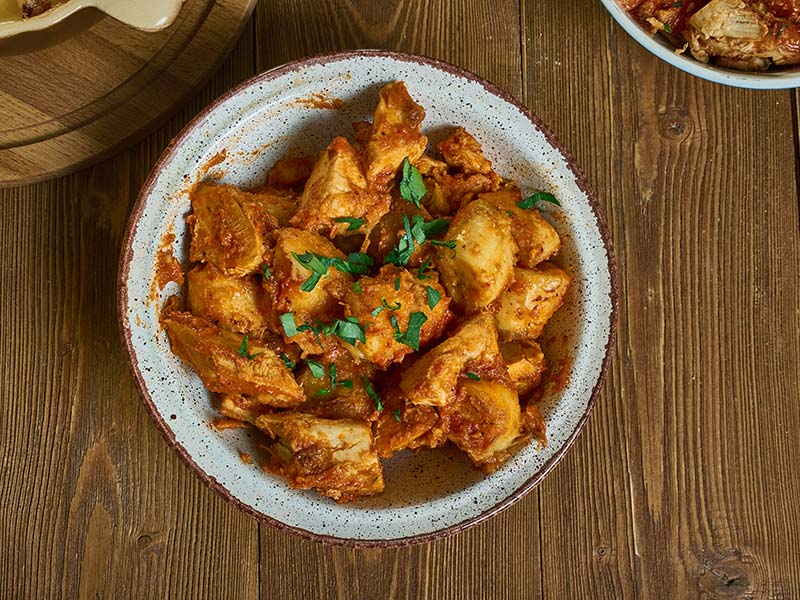
Since plantains are one of Cameroon’s most important crops, they’re featured heavily in the country’s cuisine. The vegetable cements its cornerstone status by making its way into Kondre, a traditional stew evocative of the richness of foods in Cameroonian.
It is a straightforward recipe that doesn’t take much time to prepare. The making of Kondre begins with cooking a mixture of tomato puree, spices, and meat in a large pot. Then, people add chunks of peeled green plantains to the mix and simmer all until tender.
Originally a dish of the northern tribes, Kondre is now a national dish for many Cameroonians. They usually prepare this calorie-rich and flavorful food for all kinds of special occasions, from weddings to funerals.
14. Poulet DG – Chicken Dish
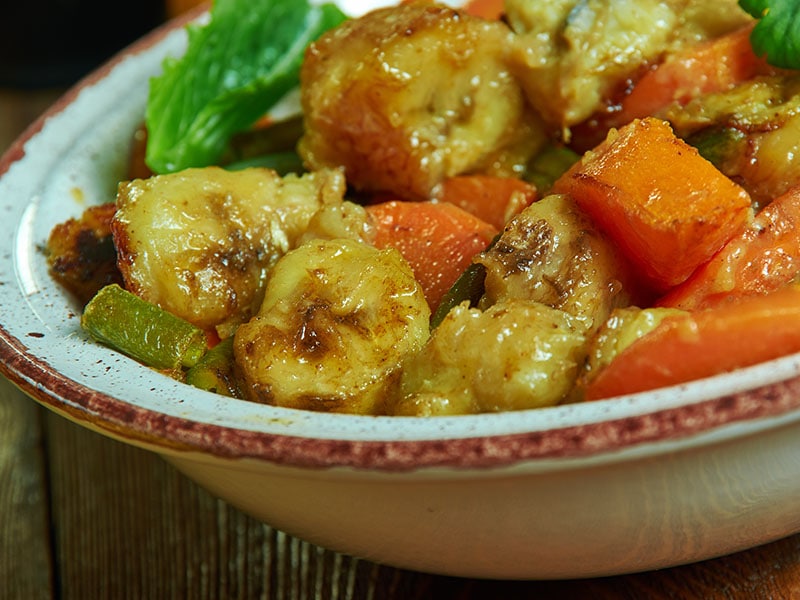
There was a time when only the upper class in colonial Cameroon enjoyed the privilege of eating this finger-licking chicken dish. The mark of social hierarchy is evident in its name: DG is short for Directeur Général, meaning something like high-ranking officials and the like.
Nowadays, everybody can gain access to this culinary wonder. This once luxurious dish is surprisingly simple to prepare. All you need to do is to cook fried (ideally unripe) plantains and slightly grilled chicken pieces in a savory tomato sauce alongside chopped veggies.
That’s all, and your sublime Poulet DG is good to go. It took ordinary Cameroonians decades to finally have a taste of it. Luckily, you don’t have to wait that long to find out how passionately the dish can arouse taste buds with its fattiness and diverse flavors.
15. Soya – Skewered Meat
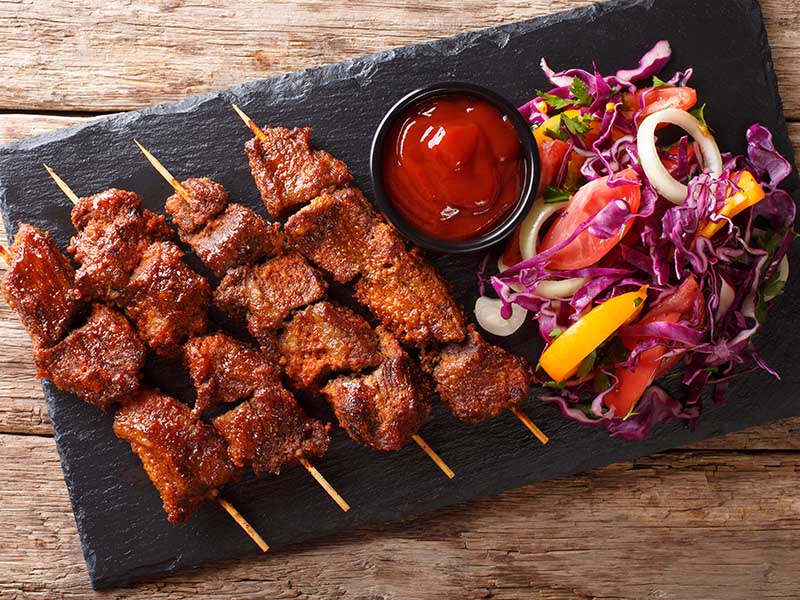
When your appetite isn’t in good shape, go to the streets of Cameroon to awaken your passion for good food. You will easily run into a Soya stand selling irresistible skewered meat that will help you rediscover your lust for life.
Soya usually comes in the form of beef and, sometimes, goat meat. The key to perfect Soya lies in the way to season pieces of tender meat with a host of peppery spices before putting them on sticks and grilling over a charcoal fire.
In Cameroon, the Hausen people are recognized as some of the best Soya vendors. They hold the closely-guarded secret of how to create juicy, spicy grilled meat. Don’t forget to serve Soya with raw onions and grilled plantains like the locals.
16. Poisson Braisé – Roast Fish
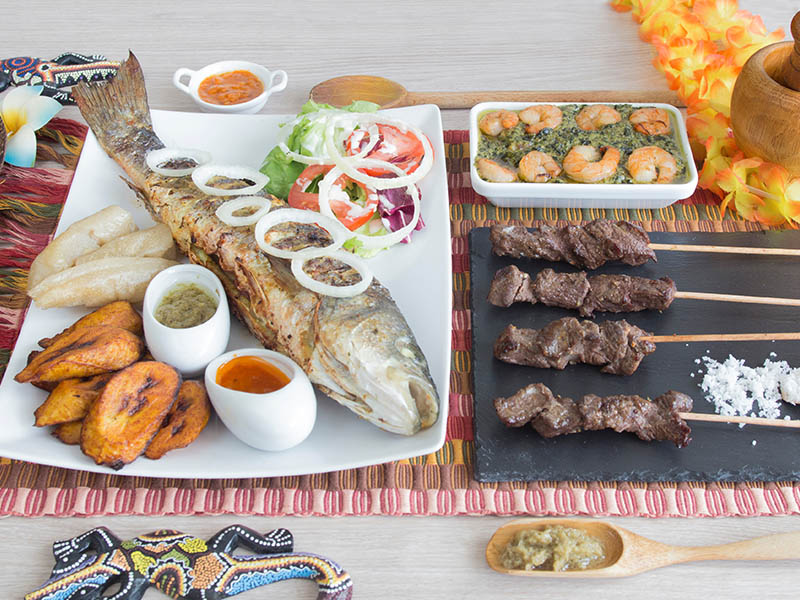
What is the most memorable Cameroonian dinner dish? You should find the answer from the Duala (or Sawa) people living mainly in the coastal Littoral Province. Their delicacy is Poisson Braisé (“roast fish”), whose umami-packed flavor will stimulate your saliva production.
As you can guess, Poisson Braisé involves grilling gutted fish with charcoal, although using the oven is acceptable. But the heart and soul of this dish are the exotic spices of Africa. The fish needs pèbè (false nutmeg), country onion (a rainforest spice), or white pepper to ascend.
Those spices are pretty difficult to gather outside Africa, making Poisson Braisé a valuable delicacy in Cameroon. In addition, it’s a well-loved dish in Ivory Coast. Like other grilled dishes, this one is best paired with Bobolo, Fufu, and cooked plantains.
17. Born House Planti
This dish earns a special place in Cameroonian cuisine as well as culture. According to tradition, when a baby comes to this world in Cameroon, the family will cook Born House Planti to welcome them, hence the “Born House” part. “Planti” is a corruption of “Plantain”.
The use of plantain possibly comes from the ancient practice of burying the umbilical cord of the newborn baby by the plantain tree. To prepare the dish for the babe, Cameroonian families cook green plantain pieces with bitter leaves, spices, and meat to create a starchy, savory stew.
An adorable local custom is to sing and dance while waiting for Born House Planti to be ready. A popular lyric usually goes something like “Planti eh, planti eh/ Planti for pikin/ E sabi sweet!” (“pikin” means “child”). The banana dish isn’t just about food; it’s alive with sentiments, too!
Cameroonian birth celebration is becoming more and more Westernized. Luckily, the love for Born House Planti remains a hallmark of the country’s distinct culture.
18. Koki – Steamed Bean Cake
While Cameroonians cook Born House Planti in honor of babies, they prepare Koki for newlyweds. The dish is a moist pudding-like cake. It is widely available at many food stalls and roadside eateries, but wedding parties are the best hunting ground for it.
The main ingredient for Koki is black-eyed pea (or cowpea), a nutritious legume that Africans have cultivated from time immemorial. The food processor is necessary to puree peeled peas with spinach and herbs. Then, the paste will be wrapped in plantain leaves and steamed.
Depending on your needs, Koki can come in various sizes, usually as small as a golf ball. The rich, earth-tasting steamed cake is delicious enough on its own, but try the Cameroonian way of serving it with boiled plantains. They are great together as husband and wife are.
19. Puff-Puff – Deep-Fried Dough
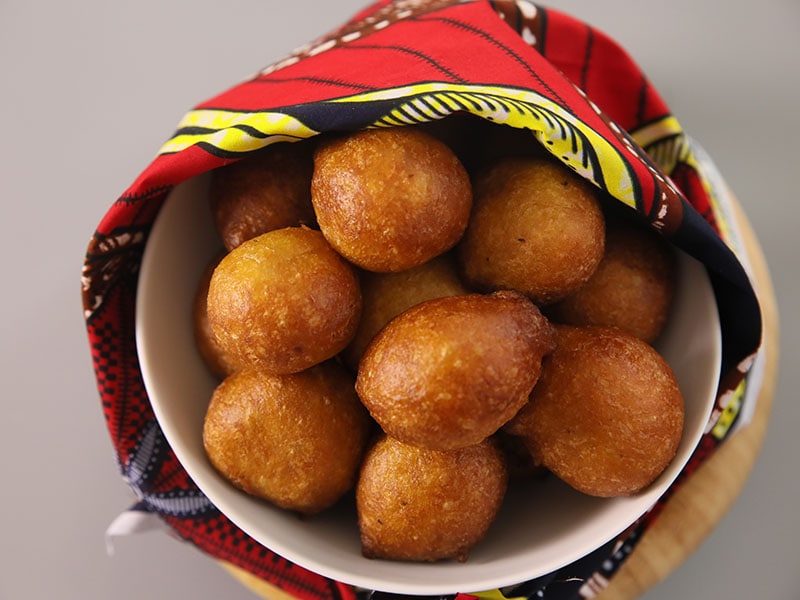
Puff-Puff is a riveting Cameroonian street food. It easily charms you with its crispy, golden exterior and its soft inside rich with the aroma of spices. The snack is also a favorite comfort food for Nigerians and Ghanaians; the latter calls it Bofrot.
Puff-Puff is made from a deep-fried dough of yeast-raised flour, water, sugar, and salt. While it usually goes with corn porridge, the most suitable accompaniment is a mixture of sauteed beans and tomatoes. To order the combo, you should use its French name Beignet Haricot.
20. Accra Banana – Deep-Fried Banana Fritter
Street food lovers can’t miss out on this amazing Cameroonian dessert with bananas. It is an authentic African bite with a crispy texture and a flavor as diverse as the continent’s culinary wealth itself.
This heavenly-tasting African dessert requires a creamy batter of mashed bananas, cornmeal, baking soda, and flour first.
After the dough has risen, the next step is to deep-fry in an oil spoonful by spoonful until golden brown. Abracadabra! Accra Banana, in its hottest and sweetest form, is ready to serve you.
21. Egusi Pudding
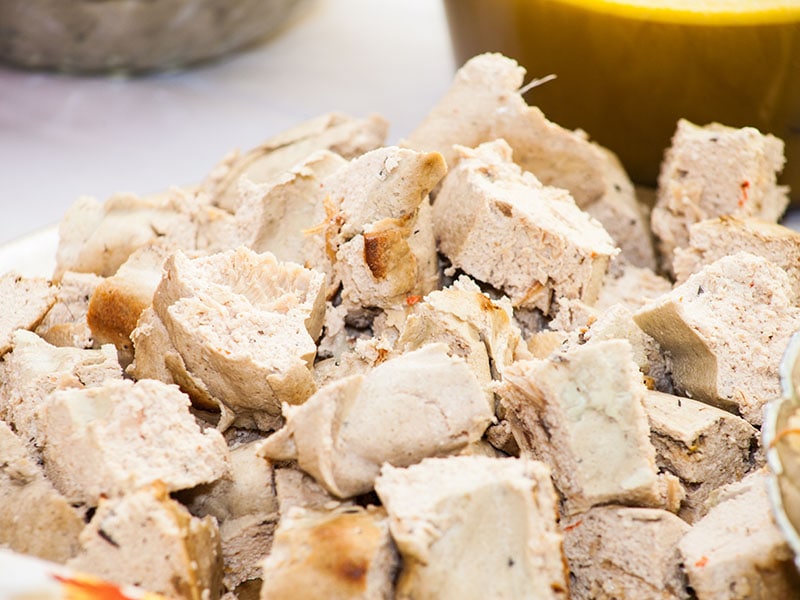
If you’re interested in African cuisine, Egusi is something you should know about. Extremely useful in Cameroonian cuisine, it is the term for the protein-rich seeds of certain plants, including melon and pumpkin. Additionally, it is necessary for a famous pudding of the same name.
People make it by mixing ground Egusi with water, spices, and shredded meat into a smooth paste. Like other Cameroonian dishes, the next step is to wrap it in banana leaves to steam in the oven until soft and aromatic.
The main side dishes to go with this pudding are Fufu, Bobolo, and boiled plantains. Since melon seeds are seldom available in large quantities, this spongy, savory dessert is a delicacy reserved for special occasions like weddings.
Some people believe that the quality of Egusi pudding, including its taste and how neat its wrapping leaves are, can foretell the success of the marriage.
Preparing flavorful Egusi pudding is a daunting task unless you follow this guide.
22. Chin Chin – Croquette
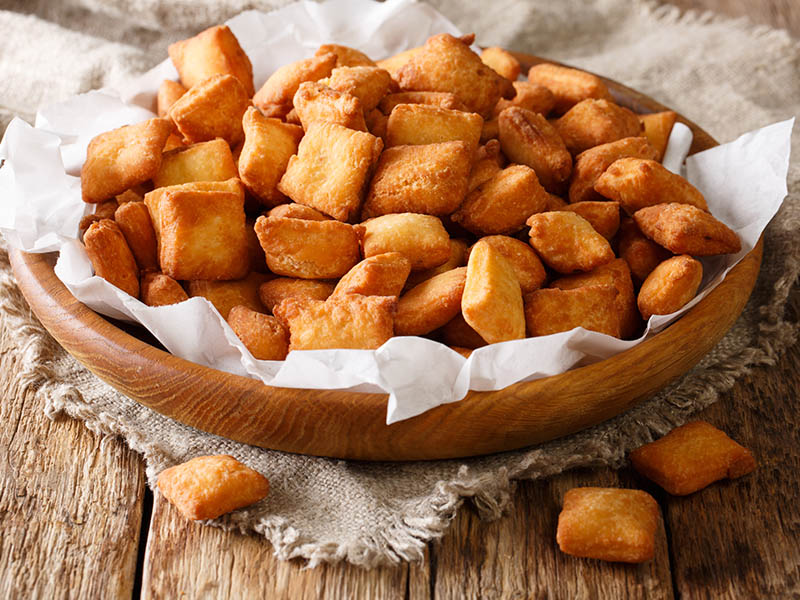
Can you resist being led to the temptation of this enticing West African snack? Chin Chin is a wonderful combination of wheat flour, milk, eggs, and black-eyed peas. It has a crunchy texture and a rich, fatty taste, thanks to being deep-fried in oil.
Most Cameroonian variations also contain ground nutmeg, giving them a slightly spicy and aromatic flavor, unlike other greasy fried snacks. They come in many sizes and shapes, from chip- to donut-like, so you will always be spoiled for choices.
Count Your Blessings With Cameroonian Foods
As you can see, Cameroonian foods, traditional and modern alike, are versatile and suitable for various needs. There are nutritious and toothsome meaty dishes that will make your mouth water non-stop. At the same time, healthy vegan recipes are always at your service.
“African century” is the belief that the continent will experience revival in this era. Hopefully, the delicious dishes from Cameroon, a stunningly beautiful West African country, will stop being a hidden gem and instead move to the forefront of international recognition.
You can help with that process. Share this post with your friends and loved ones to popularize the merits of delectable Cameroonian dishes. Many thanks! Don’t forget the comment section is open to anyone with great ideas to tell.
